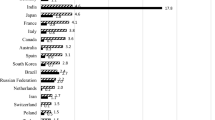Abstract
Beginning from the premise that research competitiveness at the university level is the starting point for national competitiveness as a whole, this paper analyzes the correlation between university research-related performance and the scholarly or academic resources available through a country’s library system. An analysis of this correlation from two different angles — a macroscopic approach considering universities in OECD nations and a microscopic approach focusing only upon universities in Korea — found that there is indeed a significant correlation between university research performance and the scholarly information available at libraries. A regression analysis of the two approaches also found that the more journal titles subscribed to by university libraries and the higher their budget for materials, the greater the contribution university libraries make to university research competitiveness in Korea as well as other OECD countries. In this light, in order for Korea to reach a level of research competitiveness comparable to other OECD members, policies need to be created that will effectively increase the number of journals subscribed to by university libraries.
Similar content being viewed by others
References
American Library Association, Association of College and Research Libraries (2005), Academic Library Trends and Statistics. ALA, Chicago.
Association of Research Libraries (2005), ARL Statistics: 2003–2004. ARL, Washington, D.C.
Bilich, M. Das Graçcas R., Bilich, F., Analysis of World Scientific and Technological Productivity. accessible via http://www.triplehelix5.com/pdf/A161_THC5.pdf
Budd, J. M. (1995), Faculty publishing productivity: An institutional analysis and comparison with library and other measures, College & Research Libraries, 56(6): 547–554.
CARL historic data, 1969–2004.xls. accessible via http://www.caul.edu.au/stats/caul2004.xls
Dundar, H., Lewis, D. (1998), Determinants of research productivity in higher education, Research in Higher Education, 39(6): 607–631.
Hiroyuki, Tomizawa & al. (2006), A bibliometric analysis of scientific literatures cited by influential patents, Johokanri, 49(1): 2–10.
Japan Library Association (2004), Library Statistics. JLA, Tokyo.
Jones, L. V., Lindzey, G., Coggeshall, P. E. (1983), An Assessment of Research-Doctorate Programs in the United States. National Academy Press, Washington, D.C.
LibEcon, accessible via http://www.libecon.org/database/current/high_2003_belg.xls
LISU (2005), LISU Annual Library Statistics. LISU, Loughborough.
Liu, L. G. (2001), The contribution of library collections to prestige of academic programs of universities: A quantitative analysis, Library Collections, Acquisitions, & Technical Services, 25(1): 49–65.
Ministry Of Education, Culture, Sports, Science, and Technology (2005), Library Statistics of Colleges and Universities. The Ministry, Tokyo.
Ministry of Science and Technology, Republic of Korea (2005), Report on the Survey of Research and Development in Science and Technology. The Ministry, Seoul.
Morgan, D. L., Kearney, R. C., Regens, J. L. (1976), Assessing quality among graduate institutions of higher education in the united states, Social Science Quarterly, 57(3): 670–679.
OECD (2005), Main Science and Technology Indicators. OECD, Paris.
OECD (2005), OECD in Figure. OECD, Paris.
OECD (2005), OECD science, technology and industry scoreboard. OECD, Paris.
SCONUL (2005), Annual Library Statistics, 2003–2004. SCONUL, London.
Shanghai Jiao Tong University (2005), Academic Ranking of World Universities 2005. accessible via http://ed.sjtu.edu.cn/ranking2005.htm.
Soweden, P. (2005), University Library Spending on Books, Journals and Electronic Resources: 2005 update. The Publishers Association, London.
Van House, N. A. (1990), Library resources and research productivity in science and engineering: Report of a pilot study. In Communications in Support of Science and Engineering. Council on Library Resources, Washington, D.C.
Wood, E. H. (1998), Citation analysis of faculty publications: Do the library’s collection and education programs support the research? In Paper Presented at the Annual Meeting of the Medical Library Association. New Orleans, LA.
Yoon, H.-Y. (2004), Analysis and Suggestions of Academic Libraries in OECD Countries. KERIS, Seoul.
Author information
Authors and Affiliations
Corresponding author
Rights and permissions
About this article
Cite this article
Yoon, Y.H., Young, K.S. Correlation analysis between university research competitiveness and library’s scholarly information in OECD nations and Korea. Scientometrics 74, 345–360 (2008). https://doi.org/10.1007/s11192-007-1753-5
Received:
Published:
Issue Date:
DOI: https://doi.org/10.1007/s11192-007-1753-5




